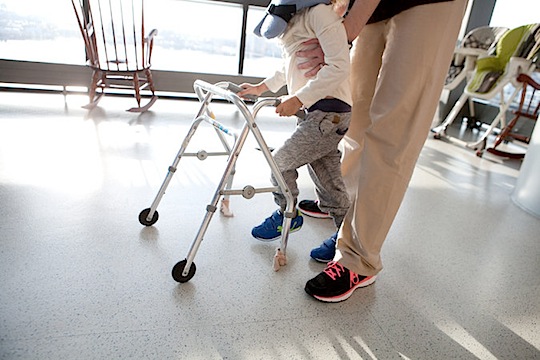Doctors Mystified by Paralysis in Dozens of Children
By CATHERINE SAINT LOUIS
OCT. 28, 2014

A 4-year-old boy who had experienced episodes of paralysis underwent physical therapy on Tuesday
in Charlestown, Mass. Credit Kayana Szymczak for The New York Times
More than 50 children in 23 states have had mysterious episodes of paralysis to their arms or legs, according to data gathered by the Centers for Disease Control and Prevention .
The cause is not known, although some doctors suspect the cases may be linked to infection with enterovirus 68 , a respiratory virus that has sickened thousands of children in recent months.
Concerned by a cluster of cases in Colorado, the C.D.C. last month asked doctors and state health officials nationwide to begin compiling detailed reports about cases of unusual limb weakness in children. Experts convened by the agency plan next week to release interim guidelines on managing the condition.
That so many children have had full or partial paralysis in a short period is unusual, but officials said that the cases seemed to be extremely rare.
“At the moment, it looks like whatever the chances are of getting this syndrome are less than one in a million,” said Mark A. Pallansch, the director of the division of viral diseases at the C.D.C.
Some of the affected children have lost the use of a leg or an arm, and are having physical therapy to keep their muscles conditioned. Others have sustained more extensive damage and require help breathing.
Marie, who asked to be identified by her middle name to protect her family’s privacy, said her 4-year-old son used to climb jungle gyms. But in late September, after the whole family had been sick with a respiratory illness, he started having trouble climbing onto the couch.
He walked into Boston Children’s Hospital the day he was admitted. But soon his neck grew so weak, it “flopped completely back like he was a newborn,” Marie said.
Typically, the time from when weakness begins until it reaches its worst is one to three days. But for her son, eight mornings in a row, he awoke with a "brand new deficit" until he had some degree of weakness in each limb and had trouble breathing. He was eventually transferred to a Spaulding rehabilitation center, where he is now.
More than 100 similar cases have been brought to the attention of the C.D.C. But only half fit the agency’s strict definition: a case of sudden-onset limb weakness since August in a patient younger than 21 who has certain spinal cord lesions.
Certain illnesses produce similar symptoms, said Dr. Mark Gorman, a neurologist at Boston Children’s Hospital, which has treated six patients. “If you include those other cases, it would dilute any potential to find a cause,” he said.
For instance, routine transverse myelitis is a neurological disorder that causes motor weakness, but scans of the spinal cord in those patients usually show inflammation in the gray and the white matter of the spinal cord. Children suffering recent instances of limb weakness have damage largely in the gray matter of the spine.
Dr. Pallansch stressed that investigators were looking at a number of possible causes. “We don’t have a single clear hypothesis that’s the leading one at this point,” he said.
An unusual outbreak of a respiratory pathogen, enterovirus 68, has spread to more than 45 states since mid-August. Some doctors have suggested that the infection could be linked to the appearance of unusual poliolike symptoms.
But not all of the children with limb weakness have tested positive for enterovirus 68. “It’s very difficult to say that this is causal,” said Dr. Teri Schreiner, a neurologist at Children’s Hospital Colorado.
The hospital has had 10 cases of limb weakness that meet the C.D.C. criteria, but only five of the patients tested positive for enterovirus 68.
Children’s Hospital of Philadelphia has treated five children with limb weakness and the characteristic spinal lesions. Yet none tested positive for enterovirus 68, said Dr. Brenda Banwell, the hospital’s chief of neurology.
It could be that specimens are tested after the virus is cleared from their body, she said, or that the tests are not “sensitive enough to pick it up.”
Alternately, Dr. Banwell said, there may be “a different infection out there,” or the paralysis may result from an immune response that damages the spinal cord even if the infection itself does not.
The prognosis for affected children is uncertain.
“The most substantial recovery happens in the first week and first month or two, then it’s a slower recovery after that,” said Dr. Keith Van Haren, a pediatric neurologist at Lucile Packard Children’s Hospital Stanford who has treated children with poliolike symptoms since August 2012.
“The spectrum of recovery is highly variable,” he added. “Some patients recover very well, others not.”
With support, Marie’s son now practices walking during physical therapy at his rehabilitation center in Charlestown, Mass. Before he got sick, he was right-handed, but now he draws pirate ships with his left.
“They just find a new way,” she said. “Little ones don’t dwell.”
Her son needs help using the toilet, eating and dressing himself again. His gains are slow, but, Marie said, “we are going in the right direction.”
A version of this article appears in print on October 29, 2014, on page A20 of the New York edition with the headline: Cause of Children’s Paralysis Remains Unclear.